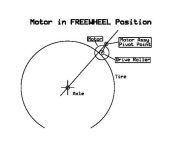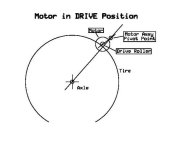deVries said:I'm so impressed with this design of yours that...
I want to try a build like yours,but I'm limited not able to do the bearing or motor shaft installations. (I don't own or have access to any machining equip -much less experience doing that skill set.) Would you consider doing a mount if I send you the roller and parts for some $ ? (Or, anyone else that can do this -please- pm me.)

What brand/model of bike rack is that?
Thanks!
Hi deVries,
Thanks for the kind words. Sorry I didn't get back with you sooner via PM. I've been out of town for a bit.
Something you may be interested in are these bearing supports Timma2500 talked about in a different thread:
These would be perfect for the EV Warrior rollers. They are the correct size bearings for the shaft and it would be very easy to make a top plate to hold them together. http://banebots.com/pc/MOTOR-ACC/PB-S5002-BB
As for the rack. I'm not sure what brand name it is but it's the same as the Schwinn ones Walmart sells:
http://www.walmart.com/catalog/product.do?product_id=9207799




